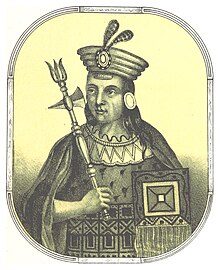
Túpac Amaru was the last Sapa Inca of the Neo-Inca State, the final remaining independent part of the Inca Empire. He was executed by the Spanish following a months-long pursuit after the fall of the Neo-Inca State.

Pachacuti Inca Yupanqui, also called Pachacutec, was the ninth Sapa Inca of the Kingdom of Cusco which he transformed into the Inca Empire. Most archaeologists now believe that the famous Inca site of Machu Picchu was built as an estate for Pachacuti.

Atahualpa, also Atawallpa (Quechua), Atabalica, Atahuallpa, Atabalipa, was the last effective Incan emperor before his capture and execution during the Spanish conquest.

Huayna Capac was the third Sapa Inca of Tawantinsuyu, the Inca Empire. He was the son of and successor to Túpac Inca Yupanqui., the sixth Sapa Inca of the Hanan dynasty, and eleventh of the Inca civilization. He was born in Tumipampa and tutored to become Sapa Inca from a young age.

Sinchi Roca, Sinchi Rocca, Cinchi Roca, Sinchi Ruq'a or Sinchi Ruq'a Inka was the second Sapa Inca of the Kingdom of Cusco and a member of the Hurin dynasty.

Manco Inca Yupanqui was the founder and monarch of the independent Neo-Inca State in Vilcabamba, although he was originally a puppet Inca Emperor installed by the Spaniards. He was also known as "Manco II" and "Manco Cápac II". He was one of the sons of Huayna Capac and a younger brother of Huascar.
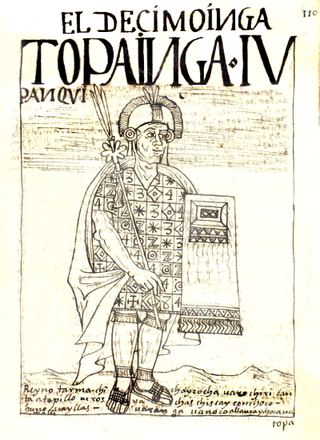
Topa Inca Yupanqui or Túpac Inca Yupanqui, translated as "noble Inca accountant," was the tenth Sapa Inca (1471–93) of the Inca Empire, fifth of the Hanan dynasty. His father was Pachacuti, and his son was Huayna Capac. Topa Inca belonged to the Qhapaq panaca. His qoya was his older sister, Mama Ocllo.

Inca Garcilaso de la Vega, born Gómez Suárez de Figueroa and known as El Inca, was a chronicler and writer born in the Viceroyalty of Peru. Sailing to Spain at 21, he was educated informally there, where he lived and worked the rest of his life. The natural son of a Spanish conquistador and an Inca noblewoman born in the early years of the conquest, he is known primarily for his chronicles of Inca history, culture, and society. His work was widely read in Europe, influential and well received. It was the first literature by an author born in the Americas to enter the western canon.

Viracocha or Wiraqucha was the eighth Sapa Inca of the Kingdom of Cusco and the third of the Hanan dynasty.
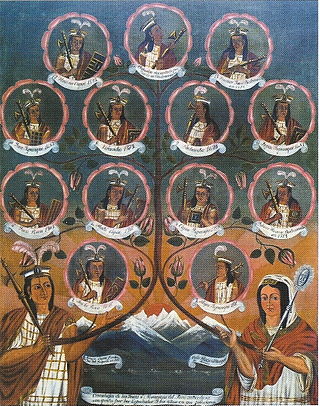
The Incas were most notable for establishing the Inca Empire which was centered in modern day South America in Peru and Chile. It was about 2,500 miles from the northern to southern tip. The Inca Empire lasted from 1438 to 1533. It was the largest Empire in America throughout the Pre-Columbian era. At the peak of the Inca Empire, it was the largest nation in the world and to this day is the largest native state in the western hemisphere. The Inca civilization was located from north to south of the western hemisphere of South America. The Inca state was known as the Kingdom of Cuzco before 1438. Over the course of the Inca Empire, the Inca used conquest and peaceful assimilation to incorporate the territory of modern-day Peru, followed by a large portion of western South America, into their empire, centered on the Andean mountain range. However, shortly after the Inca Civil War, the last Sapa Inca (emperor) of the Inca Empire was captured and killed on the orders of the conquistador Francisco Pizarro, marking the beginning of Spanish rule. The remnants of the empire retreated to the remote jungles of Vilcabamba and established the small Neo-Inca State, which was conquered by the Spanish in 1572.
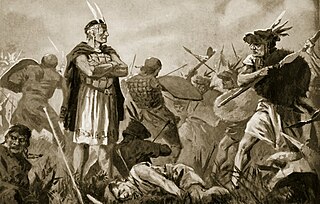
The Inca Civil War, also known as the Inca Dynastic War, the Inca War of Succession, or, sometimes, the War of the Two Brothers, was fought between half-brothers Huáscar and Atahualpa, sons of Huayna Capac, over succession to the throne of the Inca Empire. The war followed Huayna Capac's death.

The Comentarios Reales de los Incas is a book written by Inca Garcilaso de la Vega, the first published mestizo writer of colonial Andean South America. The Comentarios Reales de los Incas is considered by most to be the unquestioned masterpiece of Inca Garcilaso de la Vega, born of the first generation after the Spanish conquest.

The Cara or Caranqui culture flourished in coastal Ecuador, in what is now Manabí Province, in the first millennium CE.

The Kingdom of Cusco, also called the Cusco confederation, was a small kingdom based in the Andean city of Cusco that began as a small city-state founded by the Incas around the start of 13th century. In time, through warfare or peaceful assimilation, it began to grow and was succeeded by the Inca Empire (1438–1533).
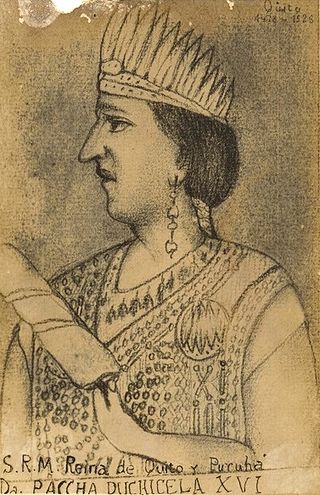
Paccha Duchicela (1485–1525), was, according to the priest Juan de Velasco, a queen regnant of Quito in 1487–1525 and co-reigned with her husband Huayna Capac, the Emperor of Inca Empire. As all the kings and queens of Quito, she is only mentioned by de Velasco. She was also a consort of the Inca Empire by marriage to the Sapa Inca Huayna Capac. She has been pointed out as the mother of Atahualpa.
Auqui was the title held by the crown prince in the Inca Empire or Tahuantinsuyu. In a generic way, all the male children of the Inca were called auquis; however, the specific title was applicable only to one of them, whose choice was based on criteria different from those of the Eastern world because his capacity was taken into account, rather than his status as first-born or legitimate son.
Capac Yupanqui, was the brother of the Inca emperor Pachacuti and an Inca general.
Apu Mayta, also called Apo Maita, was an Inca general. He commanded the army under the Inca emperors Yawar Waqaq, Viracocha Inca and Pachacuti.
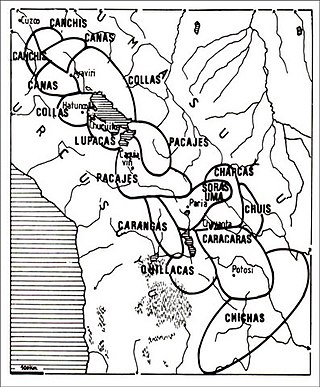
The Colla-Inca war was a military conflict fought between the Inca Empire and the Colla Kingdom between 1445 and 1450. It is one of the first wars of conquest led by Pachacuti.
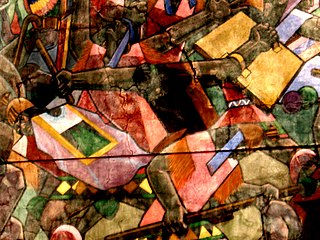
The Inca-Chanka war was a military conflict fought between Cusco and the Chanka chiefdom around 1438. It is the final conflict between these two people.
